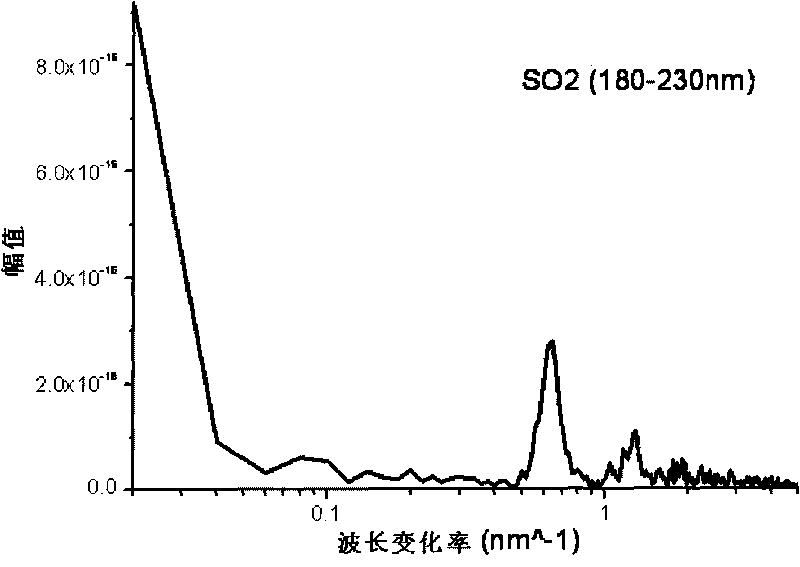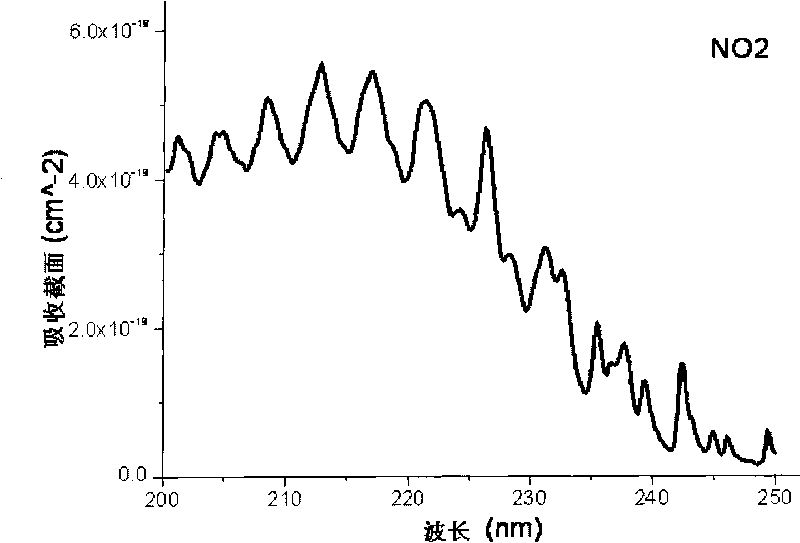Method for improving differential absorption spectrum on-line monitoring sensitivity
A technology of differential absorption spectroscopy and monitoring sensitivity, applied in absorption/scintillation/reflection spectroscopy, color/spectral characteristic measurement, spectrum investigation, etc., which can solve problems such as effective signal overlap, difficulty in low-pass characteristics, and no basis for selection judgment.
- Summary
- Abstract
- Description
- Claims
- Application Information
AI Technical Summary
Problems solved by technology
Method used
Image
Examples
Embodiment 1
[0059] In the continuous monitoring system of flue gas emissions from fixed pollution sources, the gaseous pollutants in flue gas emissions—sulfur dioxide (SO 2 ), nitrogen dioxide (NO 2 ) and nitric oxide (NO) were monitored online by differential absorption spectroscopy.
[0060] Such as the standard absorption cross section of sulfur dioxide in the range of 200-250nm (such as figure 1 Shown) do frequency domain transformation, get the frequency domain map as figure 2 shown by figure 2 OK SO 2 The characteristic change interval of the gas is (0.5-0.8cm -1 ).
[0061] For example, the standard absorption cross section of nitrogen dioxide in the range of 200-250nm (such as image 3 Shown) do frequency domain transformation, get the frequency domain map as Figure 4 shown by Figure 4 OK NO 2 The characteristic change interval of the gas is (0.16-0.2cm -1 ).
[0062] For example, the standard absorption cross section of nitric oxide in the range of 200-250nm (such ...
Embodiment 2
[0069] As shown in Example 1, in the continuous monitoring system for flue gas emissions from fixed pollution sources, the gaseous pollutants in the flue gas emissions—sulfur dioxide (SO 2 ), nitrogen dioxide (NO 2 ) and nitric oxide (NO) were monitored online by differential absorption spectroscopy.
[0070] For example, the standard absorption cross sections of sulfur dioxide, nitrogen dioxide, and nitrogen monoxide in the range of 200-250nm (respectively as figure 1 , 3 and 5) do frequency domain transformation to obtain frequency domain diagrams as figure 2 , 4 As shown in and 6, it can be determined that the total characteristic changes of the three gases of sulfur dioxide, nitrogen dioxide and nitrogen monoxide are two intervals (0.07-0.3cm -1 ) and (0.6-0.7cm -1 ), so the comb filter can be used to analyze the spectrum Figure 10 Carry out data processing, and the SO can be calculated by formula (8) 2 Concentration measured as SO 2 is 422ppm and NO is 205ppm. ...
Embodiment 3
[0072] In the air quality monitoring system, the trace gas benzene (C 6 h 6 ), formaldehyde (HCHO), ozone (O 3 ), sulfur dioxide (SO 2 ) and so on for long optical path measurements.
[0073] Perform frequency domain transformation on the standard absorption cross section of benzene in the range of 239-270nm, and determine the characteristic change of benzene from the frequency domain diagram to be 0.16-5cm -1 .
[0074] Perform frequency domain transformation on the standard absorption cross section of formaldehyde in the range of 250-356nm, and determine the characteristic change of formaldehyde from the frequency domain diagram to be 0.07-0.2cm -1 .
[0075] Perform frequency domain transformation on the standard absorption cross section of ozone in the range of 240-300nm, and determine the characteristic change of ozone from the frequency domain diagram to be 0.26-0.6cm -1 .
[0076] Perform frequency domain transformation on the standard absorption cross section of...
PUM
 Login to View More
Login to View More Abstract
Description
Claims
Application Information
 Login to View More
Login to View More - R&D
- Intellectual Property
- Life Sciences
- Materials
- Tech Scout
- Unparalleled Data Quality
- Higher Quality Content
- 60% Fewer Hallucinations
Browse by: Latest US Patents, China's latest patents, Technical Efficacy Thesaurus, Application Domain, Technology Topic, Popular Technical Reports.
© 2025 PatSnap. All rights reserved.Legal|Privacy policy|Modern Slavery Act Transparency Statement|Sitemap|About US| Contact US: help@patsnap.com



